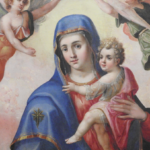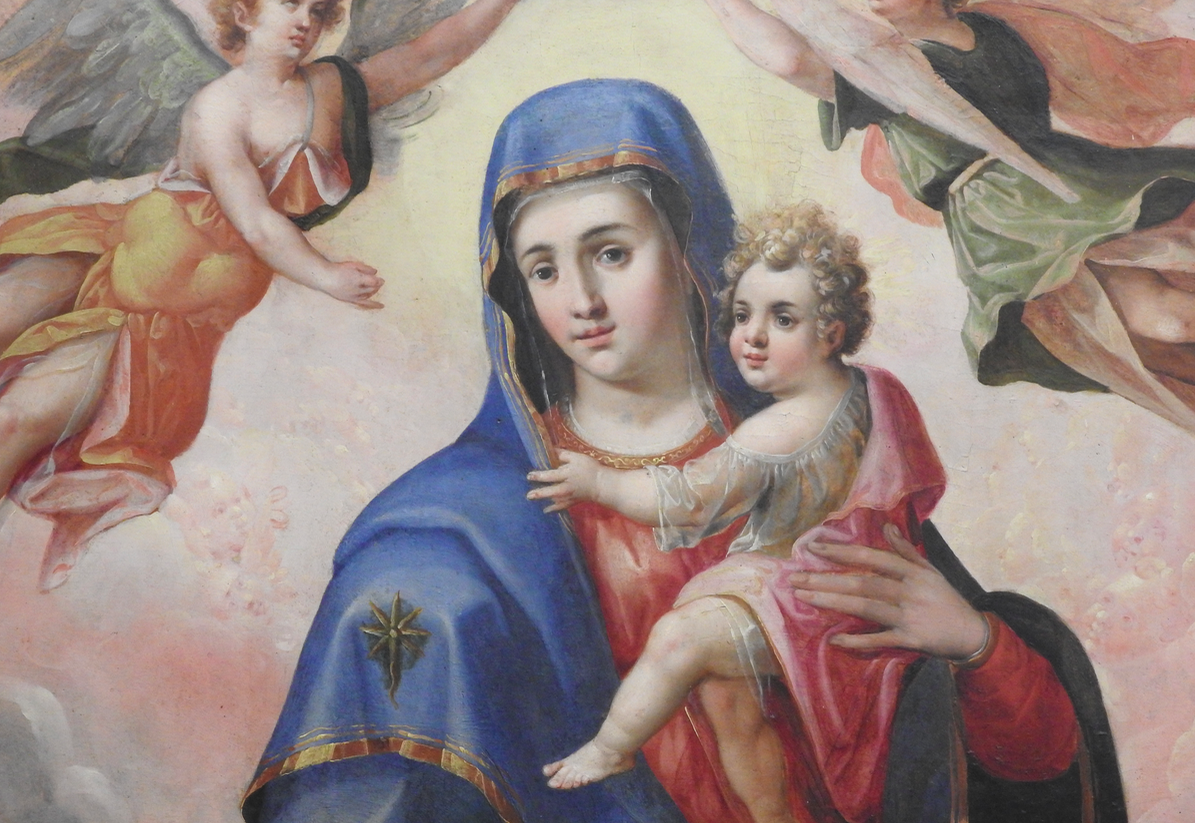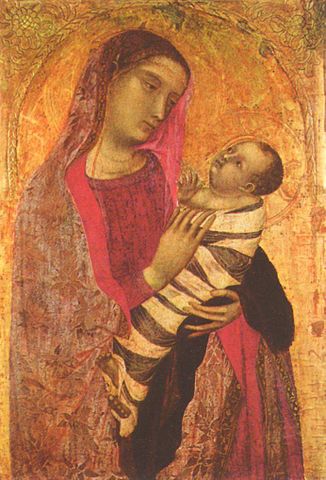
Baby Wrapping – Traditional Baby Swaddling in Italy and Beyond
Baby wrapping or traditional baby swaddling is an ancient practice that was once widespread in Italy and much of Europe and the Mediterranean. It was still used in baby care in parts of 1960s Italy. How did this custom of baby wrapping arise?
The image above, in which the baby is in a bassinet at a spinner’s feet, involved wrapping a newborn in a long broad strip of cloth that constrained the movement of the baby with its legs straightened out and its arms by its sides. This particular image comes from a 12th century English illustration for the Hunterian Psalter. Swaddling is still used today throughout the world to wrap babies to settle them for sleep, although the long binding cloth is gone and replaced with a cotton or woollen wrapping blanket.
The swaddling sometimes appears in religious images. For example, in Ambrogio Lorenzetti’s Madonna and Child, in which the Jesus’ swaddling (which is mentioned in the Gospels) is shown in the traditional form.
Swaddling cloth from Italy (1600-1625) is preserved in the Victoria and Albert Museum. In this example the wrapping has been elaborately adorned, whereas for poorer families the band may have just been a simple strip of cloth. Babies in this stage of life were referred to in Italian as “bambini in fasce”, the phrase sometimes being used to indicate an innocent in the same way as English speakers might say a “babe in arms”.

It was believed that wrapping the baby in this way would help it grow properly. Thus in 1671, Jane Sharp was advising mothers in England to “‘lay the arms right down by the sides’ and then to wrap them in bands of cloth, ‘that they might grow straight’.” The practice was phased out in England in 1800.[1]
Baby wrapping in ancient times
Jane Sharp’s ideas are far from new; and in fact, they are similar to the advice of an ancient Greek doctor, Soranus of Ephesus, who during Roman times similarly focussed on the need to ensure that babies “grow straight” and who recommend wrapping not only the body but separately the arms, fingers and legs. (Although Soranus’ elaborate recommendations may not often have been used in practice).

Archbishop of Ravenna, 545 – 553 AD
An idea of how widespread the practice comes from the following:
Swaddling, wrapping a baby to restrict its movement, is an ancient childcare practice still common in many countries today … The normality of the custom across the ancient world is attested by the fact that comment was made when babies were not swaddled, as at Sparta … In Hellenistic-period Italy the custom is attested by terracotta votive statuettes representing infants wrapped in bands of fabric. … The infant is always portrayed as firmly wrapped, … Sometimes the baby wears a cap … Sometimes feet poke out from the swaddling bands. … Soranus reports that swaddling clothes were sometimes removed after 40 days, sometimes much later, but 60 days was typically the end point.
In Bodies of Evidence : Ancient Anatomical Votives Past, Present and Future, edited by Jane Draycott, and Emma-Jayne Graham, Taylor and Francis, 2017, chapter by Fay Glinister, pp 131-146
The votive statuettes referred to above were likely offered (“voto”) to an appropriate Goddess in sacred rituals perhaps when the baby successfully passed the swaddling stage and the swaddling clothes were removed. It was the stage when a child became a member of the social and religious community and fully emerged from the womb. Examples of the statuettes have been found across Italy during both pre-Roman and Roman times.
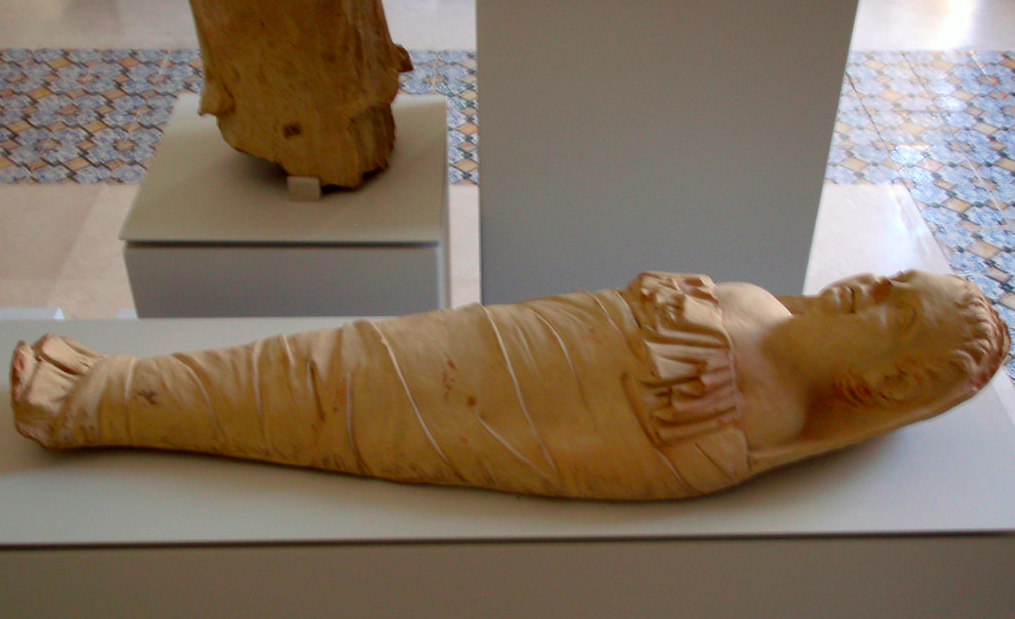
The practice is however much older. Its antiquity is seen in ancient statues from Crete which date from the second millennium BC. This is so early as to suggest that the practice may go back to the Neolithic or even earlier.
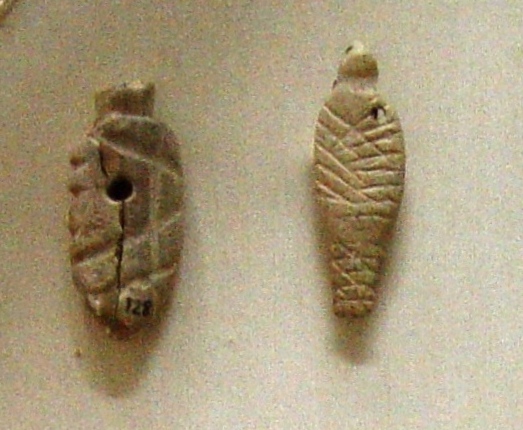
From the 18th century onwards, the male dominated medical profession in Europe sought to do away with baby swaddling. It makes interesting reading. The bindings are blamed for infant mortality and sometimes the martial vigour of the Spartans is cited as precedent for abandoning them. The critiques attack the knowledge and care of midwives (who are portrayed as ignorant and antiquated) and mothers who are accused of negligence and cruelty in the care of their newborns. Needless to say the male critiques aren’t based on a personal knowledge of child rearing (particularly in the time and place when these critiques were penned). The high infant mortality in Europe (which was universal across much of the world) likely had much more to do with economic disparities which led to widespread poverty and poor nutrition; to poor hygiene in the crowded conditions of medieval towns and cities that had only recently removed city walls; and to an absence of modern medicines to combat bacterial diseases.
Baby swaddling (although in a modern form) is now back in use and is widely adopted as it known to help young babies sleep. Modern studies have investigated the benefits and risks of use of swaddling and any connection with sudden infants’ death syndrome, recommending placing the baby on their back and discontinuing swaddling once the baby begins to roll. Tight forms of swaddling which restrict leg movement have a higher risk of hip displacement.
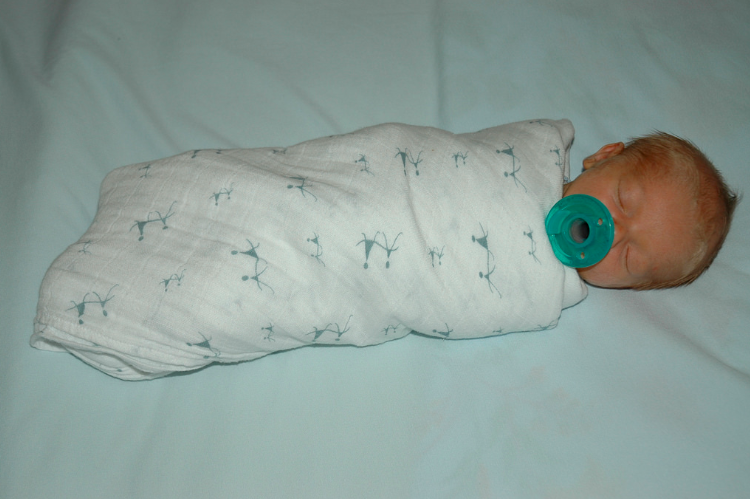
Images and Notes
[1] From narrative of the Victoria and Albert Museum online display (see below)
16th Century Swaddling Bands 1600-1625, Italy, linen with embroidered cut work, Victoria and Albert Museum, reproduced under non-commercial licence.
Fay Glinisterer, Ritual and Meaning, contextualising votive terracotta infants in Hellenistic Italy, in Bodies of Evidence: Ancient Anatomical Votives Past, Present and Future, edited by Jane Draycott
The making of infants in Hellenistic and early Roman Italy: a votive perspective Emma-Jayne Graham, Journal of World Archaeology, Volume 45, 2013 – Issue 2: The Beginnings of Life
Delle Mortalità dei Bambini Studiati nelle Cause e dei Mezzi per Rimediare Schizzo igienico per il popolo del dottor Cesare Musatti Capitolo VII Negligenza devoto alla cura ai bambini, L’illustrazione Popolare, Volumes 11-12, p 218 et seq, 1874
Red Nose Saving Little Lives, wrapping or swaddling babies
Altri Tempi, Quando si Nasceva in Casa



